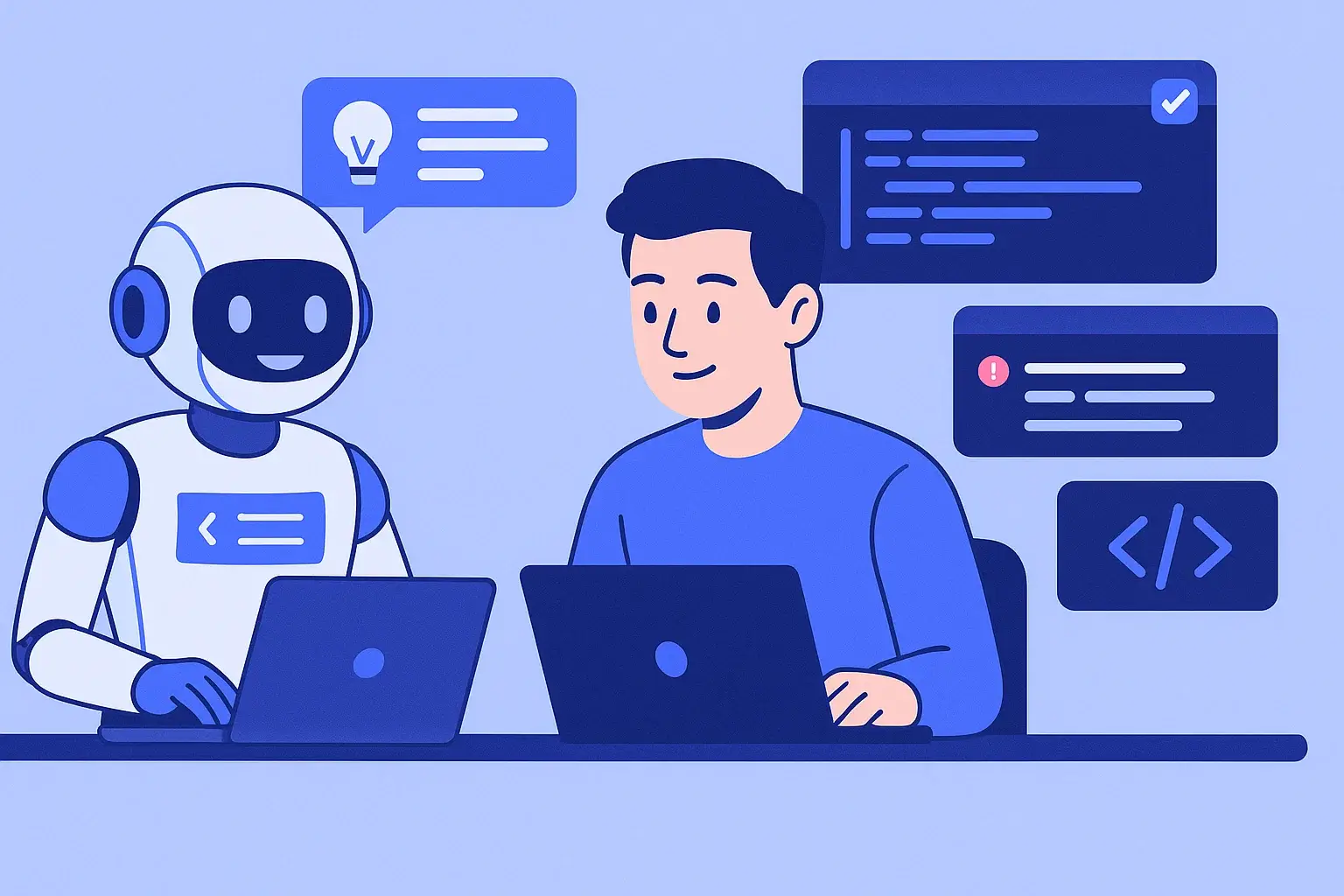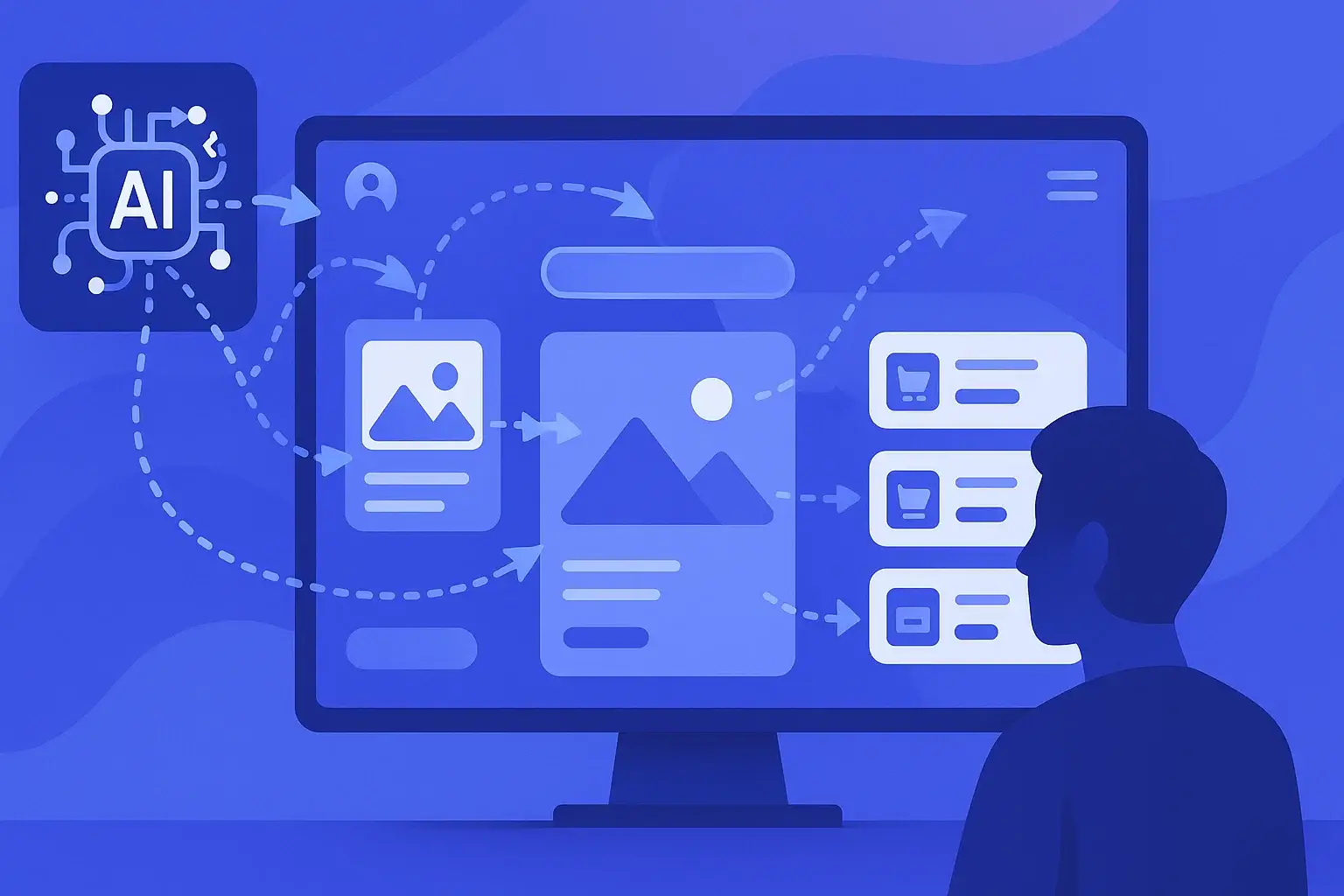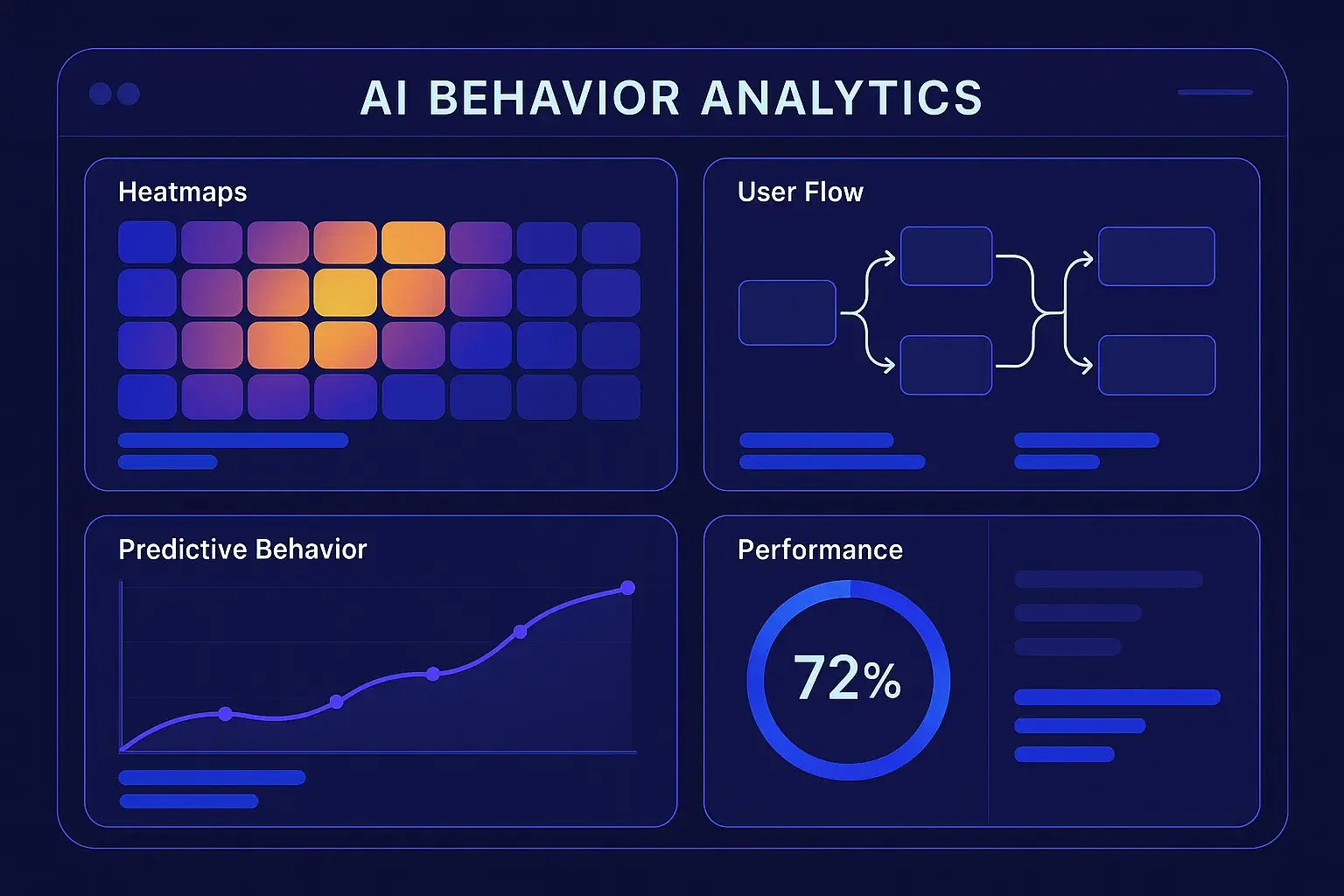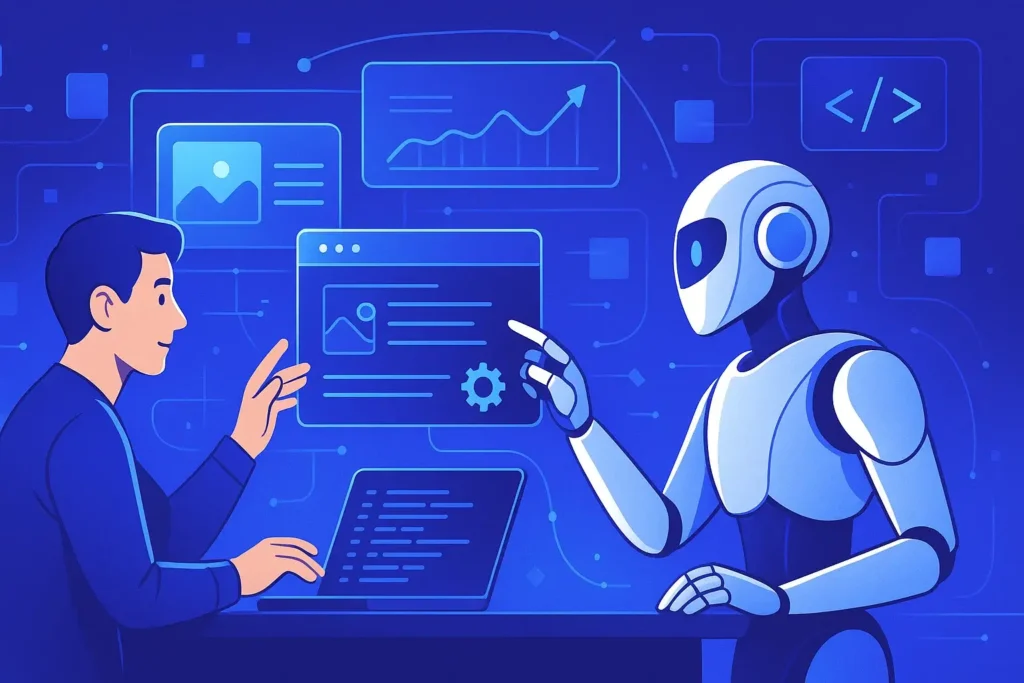AI web development is redefining how websites are designed, built, optimised, and maintained in 2025. With faster AI website builders, smarter coding assistants, and machine learning–driven UX optimisation, businesses and developers can launch more efficient, scalable, and user-centric websites than ever before. This shift is not just a technological upgrade — it’s a complete transformation of the web development lifecycle.
In this blog, we break down 7 powerful ways AI is reshaping website development, from design automation to responsive front-end engineering, analytics, testing, security, and beyond. Whether you’re a developer, business owner, or digital strategist, these insights will help you understand what’s changing — and how to stay ahead.
Why AI Web Development Matters in 2025
AI website development 2025 is no longer experimental—it has moved into mainstream adoption across startups, agencies, and large enterprises. Businesses want faster launches, consistent quality, and scalable digital experiences, and AI delivers exactly that. With machine learning web development improving code accuracy and automating repetitive tasks, teams can now focus on strategy, creativity, and user experience instead of spending hours fixing bugs or optimizing layouts.
AI web design tools are also transforming how interfaces are created. Instead of manually designing every layout, developers can now generate responsive templates, color palettes, typography systems, and UX patterns using AI-based systems. This reduces production time drastically while maintaining consistency across pages. On the development side, AI web developer tools help with automated documentation, code validation, accessibility checking, and performance optimization—making websites more secure, stable, and user-centric.
AI’s impact extends beyond speed. It is enabling websites to evolve continuously based on user behavior, device preferences, and performance data. In 2025, this adaptability is critical for brands that want to deliver seamless and personalized web experiences.
7 Ways AI Is Transforming Website Development in 2025
AI website development 2025 introduces a new era where speed, automation, personalization, and intelligent decision-making define the entire web-building lifecycle. Below are the seven most impactful changes happening right now—and how they are reshaping the future of digital products.
Way 1 — AI-Powered Website Builders Accelerate Site Creation
AI website builders have drastically reduced the time required to turn an idea into a functional website. Instead of manually writing code or dragging elements across a screen, users can now describe their requirements in natural language, and AI generates full layouts, UI components, content blocks, and even brand-aligned styling.
These tools also adapt based on industry patterns. For example, an eCommerce brand receives product-focused templates, while a SaaS startup gets modular landing pages optimized for conversions. Machine learning web development systems continuously learn from thousands of websites to improve design accuracy and performance over time.
For businesses, this means faster go-to-market timelines. For developers, it frees up time to focus on advanced customizations rather than repetitive tasks.

Way 2 — AI Coding Assistants Streamline Development Workflows
AI coding assistants are becoming a standard part of every developer’s workflow. These tools can write code, debug issues, autocomplete functions, and even suggest more efficient methods based on best practices. This reduces human errors and speeds up complex tasks that would normally take hours.
AI coding assistants also excel at refactoring legacy code, identifying vulnerabilities, and generating documentation. With multi-language support and real-time suggestions, they significantly increase productivity for front-end and back-end teams.
In 2025, these assistants are not replacing developers—they are empowering them to build more innovative solutions while reducing fatigue from repetitive tasks.
Way 3 — AI in Front-End Development and Responsive Design
Front-end development is evolving with AI tools that can automatically generate dynamic layouts, detect UI inconsistencies, suggest accessibility improvements, and create responsive designs for every screen size. Designers no longer need to manually test dozens of breakpoints—AI responsive design engines handle it instantly.
AI web design tools also analyse heatmaps, scroll depth, and behavioural signals to recommend UI improvements that enhance conversions. This leads to more user-friendly and performance-focused interfaces.
For global brands, AI ensures consistency across devices while reducing development time and improving visual accuracy.

Way 4 — AI UX Design and Personalization Enhance User Journeys
AI UX design is transforming how websites understand and respond to user behaviour. Instead of static layouts, websites now adapt in real-time—displaying different content, CTAs, color themes, or recommendations based on user intent, interaction patterns, and historical behaviour.
AI tools analyse micro-interactions such as scroll depth, cursor movement, page exits, and engagement metrics to refine the experience. Machine learning models identify friction points and suggest UX improvements that increase conversions and reduce bounce rates.
For global businesses, AI-powered personalization creates tailored pathways for each visitor—making experiences more human, intuitive, and conversion-focused.
Way 5 — AI Automates Testing, Performance Optimization & Maintenance
Traditionally, website testing requires multiple tools and extensive manual input. AI now automates this process by running continuous tests for speed, accessibility, responsiveness, code quality, security vulnerabilities, and SEO issues.
AI-driven systems detect anomalies instantly—such as broken links, slow-loading scripts, unused CSS, or layout shifts—then propose fixes or auto-correct them. This reduces downtime, improves Core Web Vitals, and ensures a smoother user experience.
Predictive maintenance powered by AI also flags performance issues before they impact users, making websites more stable and future-ready.
Way 6 — AI-Driven Analytics and Behaviour Tracking Guide Better Decisions
AI-powered analytics go beyond basic traffic numbers. They understand why users behave a certain way. These systems analyze large datasets to uncover patterns such as abandoned journeys, confusing navigation paths, or high-value segments that convert more often.
AI behaviour tracking tools also enable heatmap generation, prediction modelling, segmentation, and real-time performance recommendations. This gives businesses a deeper understanding of their users, allowing them to make data-backed UX, content, and development decisions.
With AI web design tools and behaviour insights working together, teams can create experiences that align with actual user intent—resulting in higher engagement and conversion rates.

Way 7 — AI Improves Security, SEO & Accessibility
AI-powered monitoring tools can detect threats faster than traditional systems—identifying suspicious activity, SQL injections, brute-force attempts, or unusual traffic surges. This ensures better website protection and reduces vulnerabilities.
AI-driven SEO systems optimize metadata, suggest internal linking, improve content readability, fix structured data, and evaluate search intent. Combined with machine learning, this results in higher search visibility and stronger content performance.
Accessibility also improves drastically as AI scans for WCAG issues, generates alt text, corrects color contrast, and enhances keyboard navigation. This allows brands to deliver inclusive digital experiences for a global audience.
Traditional vs AI-Enabled Web Development (Framework Comparison)
The shift from traditional development to AI-enabled processes marks one of the most significant transformations in the web industry. While traditional web development depends heavily on manual coding, long testing cycles, and static UX assumptions, AI-driven development introduces automation, intelligence, and adaptability at every stage.
Below is a clear comparison to help businesses and developers understand how workflows are evolving in 2025:
Traditional Web Development vs AI Web Development (Comparison Table)
| Aspect | Traditional Web Development | AI Web Development (2025) |
|---|---|---|
| Design Process | Manual wireframing, moodboards, static layouts | AI web design tools generate dynamic layouts, auto-correct UI issues |
| Coding | Hand-written code, time-consuming | AI coding assistants write, debug & optimize code in seconds |
| Responsive Design | Manual breakpoint checks | AI responsive design detects & fixes device inconsistencies automatically |
| UX Decisions | Based on assumptions & limited research | AI UX design uses behaviour data & predictions |
| Testing | Requires multiple tools and manual reviews | AI automates testing, performance scans & error resolution |
| Content Optimization | Manual updates & SEO checks | AI improves metadata, structure & relevance automatically |
| Maintenance | Reactive — fixes after issues occur | Predictive — AI detects issues before they impact users |
| Scalability | Slower & resource-heavy | Fast, automated & data-led |
This comparison illustrates why AI website development 2025 is becoming the new standard. Businesses gain efficiency, developers gain smarter tools, and users receive higher-quality digital experiences with minimal friction.
Implementation Checklist for Businesses & Developers
Adopting AI web development doesn’t require rebuilding your entire workflow overnight. Instead, businesses and developers can follow a structured implementation checklist to integrate AI tools gradually while improving efficiency, performance, and user experience. This ensures smoother adoption, minimal disruption, and consistent scalability.
Use this practical checklist to begin integrating AI into your website development process in 2025:
1. Define objectives & outcomes
Determine whether AI will support automation, UX optimization, faster development, improved SEO, or personalization. Clear goals help select the right tools.
2. Choose the right AI tools for your workflow
Evaluate AI website builders, AI coding assistants, AI UX design platforms, and behaviour analytics tools based on your business model and team skills.
3. Integrate AI coding assistants into your development stack
Tools that automate code suggestions, debugging, and refactoring should be added early to reduce manual workload.
4. Build AI-powered UX and personalization loops
Use AI UX design tools to monitor behaviour and dynamically adjust UI elements based on user patterns.
5. Automate testing & performance audits
Enable AI monitoring systems for Core Web Vitals, accessibility, speed, and security errors to ensure long-term quality.
6. Train your team on AI best practices
Upskilling developers and designers ensures they can use machine learning web development tools effectively.
7. Start with small modules before scaling
Begin with one area—such as AI SEO optimization or AI responsive design—and expand once results are validated.
Following this checklist allows teams to confidently integrate AI without risking workflow disruption or technical bottlenecks.
Case Studies & Real-World Use Cases of AI Web Development
AI web development isn’t theoretical anymore—global brands across industries are actively integrating AI tools to streamline development, improve UX, and personalize digital experiences. These real-world examples demonstrate how AI website development 2025 is already driving measurable business outcomes.
Use Case 1: E-commerce brands using AI for personalization
Large online retailers are deploying AI UX design systems that adjust product listings, recommendations, and promotional banners based on individual browsing behaviour. This has resulted in higher conversion rates and improved customer retention.
AI web design tools also help optimize product page layouts, predict which items users are likely to purchase, and improve A/B testing accuracy.
Use Case 2: SaaS companies automating front-end workflows
SaaS platforms increasingly use AI coding assistants to build features faster, debug issues instantly, and create consistent UI components across dashboards. This reduces release cycles and allows teams to focus on innovation instead of routine fixes.
AI in front-end development also ensures seamless responsiveness across devices—critical for global SaaS adoption.
Use Case 3: Media & content companies scaling with AI website builders
Agencies and publishers use AI website builders to rapidly create landing pages, microsites, campaign pages, and multilingual layouts. The automation helps them publish more content without expanding development teams.
Machine learning web development tools analyse audience behaviour to refine formats, typography, and layout structure.
Use Case 4: Enterprises improving security & compliance
Organizations in finance, healthcare, and government use AI web developer tools for 24/7 security scanning, anomaly detection, and compliance monitoring. AI automates alerts, identifies vulnerabilities instantly, and ensures websites meet accessibility and security standards.
This proactive approach eliminates costly security breaches and improves user trust.

The Future of AI Web Development Beyond 2025
AI web development is only in its early stages. Beyond 2025, the integration of AI into design, coding, and optimization will become even more seamless, with systems capable of autonomously building, testing, and refining entire digital ecosystems. The next wave of innovation will focus on deeper intelligence, human–AI collaboration, and anticipatory UX.
Future websites may dynamically redesign themselves in real-time based on user mood, device environment, or behavioural signals. AI agents will handle versioning, performance improvements, and code refactoring autonomously—reducing manual workloads significantly.
We can also expect smarter AI website builders capable of generating full-scale platforms, not just static pages. Hyper-personalized interfaces, conversational UI, and predictive content experiences will become standard. Overall, the role of AI will evolve from being a supportive tool to a proactive co-creator in the web development process.
Conclusion
AI web development is redefining how websites are planned, designed, built, and optimized in 2025. Whether it’s automating coding, generating responsive layouts, personalizing UX, or enhancing security, AI is now a fundamental catalyst for faster development cycles and higher-quality digital experiences. Businesses that embrace AI-driven tools gain a competitive advantage through improved efficiency, data-backed decision-making, and future-ready scalability.
As AI website development 2025 continues to evolve, human creativity combined with machine intelligence will unlock a new generation of smart, adaptive, and high-performing web solutions. Now is the time for brands, developers, and teams to integrate AI into their workflows and prepare for the next era of digital innovation.
Frequently Asked Questions (FAQ)
What is AI web development?
AI web development refers to the use of artificial intelligence and machine learning tools to automate, optimize, and enhance the process of building websites. It includes AI coding assistants, AI website builders, automated testing, AI UX design, and predictive analytics that improve speed, performance, and user experience.
Can AI replace human developers?
No. AI can automate repetitive coding, testing, and layout tasks, but it cannot replace human creativity, problem-solving, and brand understanding. AI web development tools are designed to assist developers, not eliminate them. Developers who combine AI with strong technical skills become even more valuable.
How does AI improve front-end design and responsiveness?
AI in front-end development automatically detects layout issues, fixes breakpoints, optimizes UI components, and adjusts designs for different screen sizes. Tools powered by machine learning respond to real-time behaviour and recommend layout changes that improve usability and conversions.
Is AI website development expensive?
AI tools cost more initially but reduce long-term development and maintenance costs significantly. Businesses benefit from faster turnaround times, fewer bugs, continuous optimization, and reduced manual testing — making AI website development 2025 highly cost-effective.
How does AI improve website security and SEO?
AI scans websites for vulnerabilities, unusual traffic patterns, and security threats. It also improves SEO by analyzing content, recommending metadata, fixing structured data, checking readability, and monitoring Core Web Vitals. AI web developer tools ensure better search visibility and site safety.








